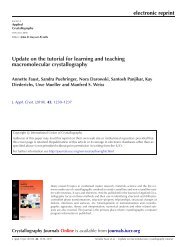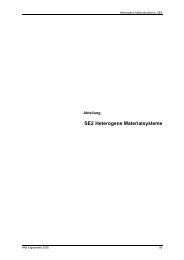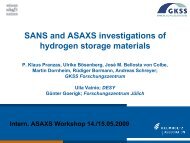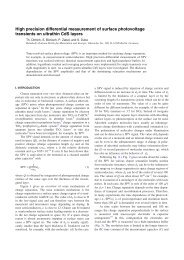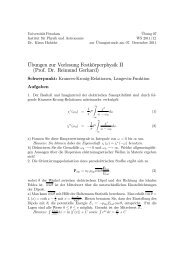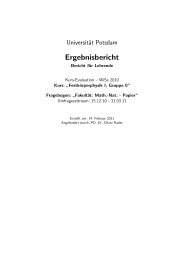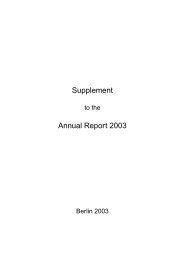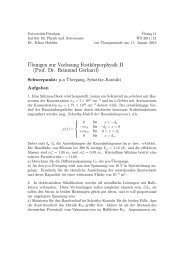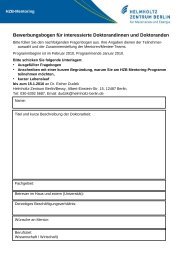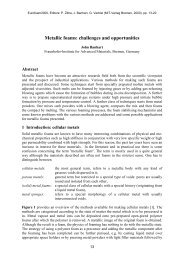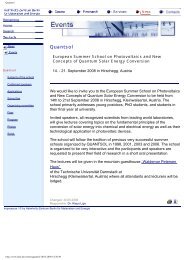XDSAPP - Helmholtz-Zentrum Berlin
XDSAPP - Helmholtz-Zentrum Berlin
XDSAPP - Helmholtz-Zentrum Berlin
Create successful ePaper yourself
Turn your PDF publications into a flip-book with our unique Google optimized e-Paper software.
Journal of<br />
Applied<br />
Crystallography<br />
ISSN 0021-8898<br />
Editor: Anke R. Kaysser-Pyzalla<br />
<strong>XDSAPP</strong>: a graphical user interface for the convenient<br />
processing of diffraction data using XDS<br />
Michael Krug, Manfred S. Weiss, Udo Heinemann and Uwe Mueller<br />
J. Appl. Cryst. (2012). 45, 568–572<br />
electronic reprint<br />
Copyright c○ International Union of Crystallography<br />
Author(s) of this paper may load this reprint on their own web site or institutional repository provided that<br />
this cover page is retained. Republication of this article or its storage in electronic databases other than as<br />
specified above is not permitted without prior permission in writing from the IUCr.<br />
For further information see http://journals.iucr.org/services/authorrights.html<br />
Journal of Applied Crystallography covers a wide range of crystallographic topics from<br />
the viewpoints of both techniques and theory. The journal presents papers on the application<br />
of crystallographic techniques and on the related apparatus and computer software.<br />
For many years, the Journal of Applied Crystallography has been the main vehicle for<br />
the publication of small-angle scattering papers and powder diffraction techniques. The<br />
journal is the primary place where crystallographic computer program information is<br />
published.<br />
Crystallography Journals Online is available from journals.iucr.org<br />
J. Appl. Cryst. (2012). 45, 568–572 Michael Krug et al. · <strong>XDSAPP</strong>
computer programs<br />
Journal of<br />
Applied<br />
Crystallography<br />
ISSN 0021-8898<br />
Received 22 December 2011<br />
Accepted 18 March 2012<br />
# 2012 International Union of Crystallography<br />
Printed in Singapore – all rights reserved<br />
1. Introduction<br />
Today’s third-generation synchrotron sources allow the collection of<br />
diffraction images of macromolecular crystals using typical exposure<br />
times of less than one second per image. Since most of the corresponding<br />
end stations for macromolecular crystallography are<br />
equipped with fast detector hardware, the time necessary to collect a<br />
complete diffraction data set has decreased from hours a few years<br />
ago to minutes. Consequently, the available time to process the<br />
collected data in ‘real time’ during a synchrotron shift has decreased<br />
considerably. This puts the experimenter under significant pressure<br />
and has resulted in the development of more and more software<br />
solutions for automated data processing. Nowadays, it is possible to<br />
process the collected data more or less automatically and with little<br />
user input, and at the same time to generate some visual feedback<br />
about the course of the processing and the resulting data quality for<br />
examination by the user. Available software suites for data integration<br />
are, for instance, MOSFLM and its graphical user interface<br />
(GUI)-based application iMOSFLM (Leslie, 2006), HKL-2000<br />
(Otwinowski & Minor, 1997), XDS (Kabsch, 1993, 2010a,b), and<br />
D*TREK (Pflugrath, 1999). The programs differ in their autoindexing<br />
methods (fast Fourier transform or difference vector clustering),<br />
their integration methods (two- and three-dimensional profile<br />
fitting) and their level of automation. Efforts to automate the integration<br />
process vary from GUIs that provide help in editing, for<br />
example, the input file of XDS and converting the output to different<br />
formats as in XDSi (Kursula, 2004) to almost complete automation of<br />
the various steps from images to a fully processed data set like in<br />
autoPROC (Vonrhein et al., 2011) or xia2 (Winter, 2010).<br />
The data processing program XDS is a sophisticated piece of<br />
software, which was originally developed for processing single-crystal<br />
monochromatic diffraction data from crystals recorded by the rotation<br />
method on a multiwire area detector (Kabsch, 1993). All the<br />
steps required to process a diffraction data set from spatial detector<br />
corrections, to indexing, integration and scaling are contained in one<br />
executable of the program. Since it does not read the headers of the<br />
diffraction images to be processed, all data relevant to the processing<br />
have to be supplied to the program in one input file, called XDS.INP.<br />
The main disadvantage of XDS is that it is a text-based software,<br />
which means that it is difficult, especially for inexperienced users and<br />
<strong>XDSAPP</strong>: a graphical user interface for the<br />
convenient processing of diffraction data using XDS<br />
Michael Krug, a,b Manfred S. Weiss, a Udo Heinemann b,c and Uwe Mueller a *<br />
a <strong>Helmholtz</strong>-<strong>Zentrum</strong> <strong>Berlin</strong> für Materialien und Energie, Institute F-I2, Macromolecular Crystallography Group<br />
(HZB-MX), Albert-Einstein-Strasse 15, D-12489 <strong>Berlin</strong>, Germany, b Max-Delbrück Center for Molecular Medicine,<br />
Robert-Rössle-Strasse 10, D-13125 <strong>Berlin</strong>, Germany, and c Institute for Chemistry and Biochemistry, Freie<br />
Universität, Takustrasse 6, D-14195 <strong>Berlin</strong>, Germany. Correspondence e-mail: uwe.mueller@helmholtz-berlin.de<br />
<strong>XDSAPP</strong> is a Tcl/Tk-based graphical user interface for the easy and convenient<br />
processing of diffraction data sets using XDS. It provides easy access to all XDS<br />
functionalities, automates the data processing and generates graphical plots of<br />
various data set statistics provided by XDS. By incorporating additional<br />
software, further information on certain features of the data set, such as<br />
radiation decay during data collection or the presence of pseudo-translational<br />
symmetry and/or twinning, can be obtained. Intensity files suitable for CCP4,<br />
CNS and SHELX are generated.<br />
those who are not very computer proficient, to run the program and<br />
to evaluate the quality of the processed data sets.<br />
In this paper, we present and describe the development and the use<br />
of <strong>XDSAPP</strong> (XDS Automation and Plotting Protocols), a GUI that<br />
combines the software packages XDS, POINTLESS (Evans, 2006) of<br />
the CCP4 software suite (Collaborative Computational Project,<br />
Number 4, 1994), XDSSTAT (Diederichs, 2006), SFCHECK<br />
(Vaguine et al., 1999) and PHENIX.XTRIAGE (Adams et al., 2010),<br />
thus allowing the crystallographer to index and integrate one or<br />
multiple diffraction data sets and to evaluate the quality of the<br />
processed data sets with minimum effort and minimum user input.<br />
Besides indexing, integration and scaling, the most probable space<br />
group is automatically determined and assigned, additional statistics<br />
are generated, and tests for potential problems such as pseudosymmetry<br />
and/or twinning are performed. A short summary of the<br />
indexing as well as the integration step is displayed for examination<br />
by the user. During integration, the most important statistics (e.g.<br />
scale factors, mosaicity, number of strong spots, beam divergence,<br />
unit-cell dimensions) are plotted synchronously. All important<br />
statistics of the different processing steps are presented within the<br />
GUI and are stored in a pdf file. Plots also include statistics generated<br />
by XDSSTAT, like the redundancy-independent merging R factor<br />
Rmeas or Rr.i.m. (Diederichs & Karplus, 1997; Weiss, 2001; Weiss &<br />
Hilgenfeld, 1997; Einspahr & Weiss, 2011) per frame. These can be<br />
used to identify images within the data set that are of much poorer<br />
quality than the rest of the data set. The decay R factor (RD) plot<br />
(Diederichs, 2006) provides information on the extent of radiation<br />
damage within the crystal during the process of data collection.<br />
<strong>XDSAPP</strong> is currently installed at the macromolecular crystallography<br />
beamlines BL14.1-3 at <strong>Helmholtz</strong>-<strong>Zentrum</strong> <strong>Berlin</strong> (HZB)<br />
(Mueller et al., 2012).<br />
2. Methods<br />
2.1. Architecture<br />
<strong>XDSAPP</strong> is a Tcl/Tk-based GUI. The main window consists of<br />
eight tabs used for the different tasks of data processing such as data<br />
input, indexing, integration, output or plotting (Fig. 1). Initially, the<br />
568 doi:10.1107/S0021889812011715 J. Appl. Cryst. (2012). 45, 568–572<br />
electronic reprint
data set to be processed has to be selected and IPMOSFLM (Leslie,<br />
1999) is used to read the image headers in order to create an<br />
appropriate XDS.INP file. Then, XDS is launched to run the tasks<br />
INIT, COLSPOT and IDXREF, and a summary of the indexing<br />
process is displayed. Next, <strong>XDSAPP</strong> calls XDS with the tasks<br />
DEFPIX, INTEGRATE and CORRECT, all with space group option<br />
‘0’ for processing of the data in space group P1. After postrefinement<br />
of the orientation and the cell parameters within the CORRECT<br />
step, one reintegration step using the refined parameters (from<br />
GXPARM.XDS) and the suggested values for BEAM DIVERGENCE,<br />
REFLECTING RANGE and their s.u. values (from INTEGRATE.LP)<br />
is performed by default. Preliminary results are displayed after each<br />
integration step. Further reintegration steps can be performed until<br />
no further improvements of resolution and/or quality in the previous<br />
integration step are detected. After the (re)integration has finished,<br />
the program POINTLESS (Evans, 2006) is used to determine the<br />
most probable space group of the data set and the CORRECT step is<br />
rerun in that space group. If the space group and unit-cell parameters<br />
of the data set are known beforehand, this step can be omitted by<br />
providing <strong>XDSAPP</strong> with these values via the ‘Settings’ tab. A resolution<br />
cut-off is applied, and intensity checks for twinning and/or<br />
pseudo-translation are done by using SFCHECK (Vaguine et al.,<br />
1999) and PHENIX.XTRIAGE (Adams et al., 2010). Several plots of<br />
the quality indicators provided by the CORRECT step are generated,<br />
as well as plots of Rmeas or Rr.i.m. per frame, and the decay R factor RD<br />
provided by XDSSTAT (Diederichs, 2006). All plots are also stored<br />
as a pdf file in the data processing directory. A summary of the<br />
processing results is presented for a quick results overview. Using the<br />
program XDSCONV, intensity files suitable for CCP4 (Collaborative<br />
Computational Project, Number 4, 1994), CNS (Brunger, 2007) and<br />
SHELX (Sheldrick, 2008) are produced.<br />
2.2. Hardware provisions<br />
XDS is the only data processing program known to us that is able<br />
to utilize multiprocessor architectures during the course of the data<br />
processing. In particular, the most time-consuming steps, such as the<br />
search for strong spots for auto-indexing or the integration of the<br />
images, are highly parallelized. Within the infrastructure at HZB, we<br />
Figure 1<br />
Start-up window of <strong>XDSAPP</strong>. The eight tabs are (from left to right) ‘Input’,<br />
‘SingleDataset’, ‘MultipleDatasets’, ‘Statistics’, ‘Plotting Utilities’, ‘Logfiles and<br />
pictures’, ‘Settings’ and ‘Running output’.<br />
are using an HP-DL580 G7 40-CPU-core server, which is attached to<br />
a large storage area network array via several fibre channel uplinks.<br />
2.3. Software environment<br />
<strong>XDSAPP</strong> runs under Linux and needs the installation of Tcl/Tk<br />
version 8.4 or newer. In addition to the above-mentioned crystallographic<br />
software, an installation of gnuplot (at least version 4.0) and<br />
ImageMagick (6.2.5 or newer) is needed. In order to have the full<br />
functionality of <strong>XDSAPP</strong>, the XDS viewer and the old XDS viewing<br />
program VIEW also have to be installed.<br />
2.4. Usage<br />
computer programs<br />
The main window of <strong>XDSAPP</strong> is separated into eight different<br />
tabs representing the different possible tasks (Fig. 1). After having<br />
started <strong>XDSAPP</strong>, the user first has to select the detector used for<br />
data collection within the ‘Input’ tab. Here, one can also select the<br />
directory in which <strong>XDSAPP</strong> is looking for diffraction images (the<br />
default is the directory from which <strong>XDSAPP</strong> has been started). By<br />
pushing the appropriate button within the ‘SingleDataset’ tab, a<br />
dialog window (Fig. 1 inset) allowing the selection of a data set opens.<br />
The selected data set can then be indexed or processed by clicking the<br />
appropriate buttons within the ‘SingleDataset’ tab. Results of the<br />
indexing step are displayed within the tab. During integration,<br />
preliminary results are given within the ‘SingleDataset’ tab. The most<br />
important statistics of the integration step are presented as plots<br />
synchronously for each integration cycle within the ‘Statistics’ tab<br />
(Fig. 2). After finishing, a summary of the processing results of the<br />
data set is given within the ‘SingleDataset’ tab (Fig. 3), and plots of<br />
statistics generated by the CORRECT step and XDSSTAT can be<br />
viewed as plots in the ‘Statistics’ tab (Fig. 4).<br />
In the ‘MultipleDatasets’ tab the user can provide <strong>XDSAPP</strong> with a<br />
directory containing multiple data sets. All the data sets within this<br />
directory and its subdirectories will then be processed subsequently.<br />
In the ‘Logfiles and pictures’ tab all the log files of the different<br />
processing steps and the images generated by XDS and XDSSTAT<br />
can be viewed. In the ‘Plotting Utilities’ tab plots of the statistics of a<br />
processed data set can be generated. This can also be applied to a<br />
Figure 2<br />
The ‘Statistics’ tab displays plots of the most relevant statistics of the different XDS<br />
processing steps (COLSPOT, INTEGRATE, CORRECT) and XDSSTAT. The<br />
statistics of the INTEGRATE step can be followed concurrently during the<br />
integration. This example (case study 1) shows the statistics after 120 out of the 180<br />
frames of the data set have been integrated.<br />
J. Appl. Cryst. (2012). 45, 568–572 Michael Krug et al. <strong>XDSAPP</strong> 569<br />
electronic reprint
computer programs<br />
data set that has been processed by XDS in the conventional manual<br />
way. In the ‘Settings’ tab the settings of, for example, parameters for<br />
XDS like the spot range, direct beam position or resolution range can<br />
be changed. If the space group and unit-cell parameters of a data set<br />
are known beforehand they can also be given here and <strong>XDSAPP</strong> will<br />
process the data set in the given space group.<br />
The ‘Settings’ tab also provides the possibility to define the resolution<br />
limit of a data set by setting threshold values for completeness,<br />
I/ (I) and Rmeas (or Rr.i.m.). <strong>XDSAPP</strong> will then run XDS to the<br />
maximum resolution possible during the first integration run and use<br />
the threshold values to define the resolution cut-off of the data set for<br />
the subsequent integration run.<br />
3. Results and discussion<br />
In order to demonstrate the versatility of <strong>XDSAPP</strong>, two data sets<br />
collected at BL14.1 at BESSY II were processed with <strong>XDSAPP</strong> using<br />
the default settings.<br />
3.1. Case study 1<br />
The first case study is a data set of a cubic insulin crystal collected<br />
at a wavelength of 1.77 A˚ (Faust et al., 2008). The image range(s) for<br />
collecting strong spots during the COLSPOT step are set dynamically<br />
by <strong>XDSAPP</strong> depending on the overall number of images a data set<br />
consists of. In this case, frames 1–12 and 84–96 were used to collect<br />
strong spots from. As this data set is of rather high quality, the<br />
resulting indexing was very accurate, as shown by a standard deviation<br />
of spot position of 0.34 pixels before and 0.29 pixels after<br />
refinement. The mean absolute difference between observed and<br />
fitted indices was also quite low (DH = 0.03, DK = 0.02, DL = 0.03).<br />
Consequently, the first integration step already produced good results<br />
so that the second, automatically launched, integration step only led<br />
to a minor improvement of data quality. Since it is not possible to<br />
distinguish between space group I23 and I213 from diffraction data<br />
alone, <strong>XDSAPP</strong> processed the data set in space group I23. A<br />
comparison with the manual XDS processing of the data set is given<br />
in Table 1. For the manual processing of this data set the value range<br />
for trusted pixels on the detector was adjusted, because otherwise<br />
XDS did not exclude all of the intruding hardware shadows from the<br />
trusted region of the detector. This was done by inspecting the file<br />
Figure 3<br />
Case study 1. A summary of the processing results of the data set is given within the<br />
‘SingleDataset’ tab.<br />
BKGPIX.cbf, adjusting the values for the trusted pixel range and<br />
repeating the DEFPIX step until all of the intruding hardware<br />
shadows were visually removed from the trusted region. Presently,<br />
<strong>XDSAPP</strong> is not able to perform such an adjustment automatically. As<br />
a consequence, the number of total reflections is smaller for the<br />
manually processed data set. Also, the R values as well as the<br />
completeness for the highest-resolution shell are lower in the case of<br />
the manual processing. Nevertheless, the quality of the two processing<br />
runs is very much comparable. As can be seen from Fig. 4(a),<br />
data collection at this long wavelength led to a clearly detectable<br />
anomalous signal of the data set. The anomalous correlation coefficient<br />
CCanom is 0.65 for the data set processed by <strong>XDSAPP</strong> and 0.59<br />
for the data set processed manually. <strong>XDSAPP</strong> also ran SFCHECK<br />
and PHENIX.XTRIAGE on the output of XDS to test for twinning<br />
or pseudo-translation. In this case SFCHECK identified a twinning<br />
fraction of 5.8%, which is a number too small to be significant.<br />
Figure 4<br />
(a) Case study 1. Plots of statistics generated by the CORRECT step. The two<br />
lower plots of the anomalous correlation and SigAno = [|F(+) F( )|] / [|F(+)<br />
F( )|] versus the resolution show that this data set exhibits a clearly detectable<br />
anomalous signal. (b) Case study 1. Plots of statistics generated by XDSSTAT.<br />
Rmeas (or Rr.i.m.) per frame (left) helps to identify parts of high or low quality of a<br />
data set. A steady increase of RD with increasing frame number difference is an<br />
indicator of radiation damage (right).<br />
570 Michael Krug et al. <strong>XDSAPP</strong> J. Appl. Cryst. (2012). 45, 568–572<br />
electronic reprint
Table 1<br />
Data collection and processing statistics of case study 1.<br />
Data set Insulin <strong>XDSAPP</strong> Insulin manual<br />
Wavelength (A˚ ) 1.77<br />
Crystal–detector distance (mm) 50<br />
Rotation range per image ( ) 1.0<br />
Total rotation range ( ) 180<br />
Exposure time per image (s) 2.4<br />
Space group<br />
Resolution range (outer range) (A<br />
I23 or I213<br />
˚ ) 50.0–1.55 (1.65–1.55) 50.0–1.55 (1.65–1.55)<br />
Unit-cell parameters<br />
a, b, c, , , (A˚ , )<br />
78.08, 78.08, 78.08,<br />
90.0, 90.0, 90.0<br />
78.07, 78.07, 78.07,<br />
90.0, 90.0, 90.0<br />
Mosaicity ( ) 0.098 0.108<br />
Total No. of reflections 215 318 179 837<br />
Unique reflections 22 106 22 057<br />
Multiplicity 9.74 8.15<br />
hI/ (I )i 44.7 (8.26) 42.2 (9.1)<br />
ISa 26.98 27.36<br />
Completeness (%) 99.4 (96.5) 99.1 (94.6)<br />
Rmerge† (%) 3.9 (24.1) 3.2 (14.9)<br />
Rmeas/Rr.i.m.† (%) 4.0 (25.6) 3.4 (16.8)<br />
Rp.i.m.† (%)<br />
Overall B factor from Wilson plot (A<br />
0.9 (8.2) 1.0 (5.5)<br />
˚ 2 ) 22.13 21.52<br />
† Rmerge ¼ P P<br />
hkl i jIiðhklÞ hIðhklÞij= P P<br />
hkl i IiðhklÞ, where IiðhklÞ is the integrated<br />
intensity of a given reflection and hIðhklÞi is the mean intensity of multiple corresponding<br />
symmetry-related reflections. Rmeas ¼ Rr:i:m: ¼ P hkl½N=ðN 1ÞŠ 1=2 P i jIiðhklÞ hIðhklÞij= P P<br />
hkl i IiðhklÞ, where N is the multiplicity of a given reflection.<br />
Rp:i:m: ¼ P hkl½1=ðN 1ÞŠ 1=2 P i jIiðhklÞ hIðhklÞij= P P<br />
hkl i IiðhklÞ. ISa = I/ (I )asymptotic<br />
represents the highest possible signal-to-noise ratio of a data set (Diederichs, 2010). Data<br />
sets with ISa values of 25 or greater are considered to be very good and should allow for<br />
straightforward structure determination. The calculation of ISa has been implemented in<br />
XDS since December 2009.<br />
Table 2<br />
Comparison of overall statistics after the first and the second integration step with<br />
refined parameters for the Tt-IPMDH data set (case study 2).<br />
No resolution cut-off was applied at that stage of processing.<br />
Integration 1 Integration 2<br />
hI/ (I )i 6.12 9.93<br />
Completeness (%) 88.1 92.7<br />
R meas or R r.i.m. (%) 20.4 13.7<br />
ISa 13.89 26.12<br />
<strong>XDSAPP</strong> displays the overall numbers of the twinning tests by<br />
SFCHECK and PHENIX.XTRIAGE and stores the complete output<br />
of these programs in log files within the processing directory.<br />
3.2. Case study 2<br />
The second case study is a data set of a Tt-IPMDH (isopropylmalate<br />
dehydrogenase from Thermus thermophilus) crystal. This data<br />
set consists of 720 diffraction images. In this case, frames 1–20 and<br />
350–370 were used to collect strong spots from. Owing to the<br />
comparatively poor quality of the diffraction images, the indexing<br />
turned out to be less accurate than in case study 1, which is reflected<br />
in a rather large standard deviation of the spot position of 5.66 pixels<br />
before and 1.22 pixels after refinement and quite big mean absolute<br />
differences between observed and fitted indices (DH = 0.03, DK =<br />
0.09, DL = 0.08). Consequently, the results of the first integration step<br />
were also unsatisfactory. Nevertheless, it turned out to be possible to<br />
improve the integration significantly by the second, automatically<br />
launched, integration step using the post-refined parameters<br />
(Table 2). For example, the value of ISa (Diederichs, 2010) almost<br />
doubled from integration step 1 to integration step 2. As can be seen<br />
from the numbers presented in Table 3, <strong>XDSAPP</strong> processed the data<br />
set to slightly lower resolution than in the manual processing. This is a<br />
consequence of the default parameters for resolution cut-off in the<br />
Table 3<br />
Data collection and processing statistics of case study 2.<br />
computer programs<br />
Data set Tt-IPMDH <strong>XDSAPP</strong> Tt-IPMDH Manual<br />
Wavelength (A˚ ) 0.91841<br />
Crystal–detector distance (mm) 301.42<br />
Rotation range per image ( ) 0.25<br />
Total rotation range ( ) 150<br />
Exposure time per image (s) 4.0<br />
Space group<br />
Resolution range (outer range) (A<br />
C2221 or C222<br />
˚ ) 50.0–2.94 (3.12–2.94) 50.0–2.8 (2.97–2.80)<br />
Unit-cell parameters<br />
a, b, c, , , (A˚ , )<br />
51.33 153.69 176.48,<br />
90, 90, 90<br />
51.31 153.68 176.41,<br />
90, 90, 90<br />
Mosaicity ( ) 0.166 0.145<br />
Total No. of reflections 92 765 128 591<br />
Unique reflections 15 175 17 657<br />
Multiplicity 6.11 7.28<br />
hI/ (I )i 20.2 (3.2) 19.4 (2.0)<br />
ISa 27.86 28.71<br />
Completeness (%) 99.3 (98.3) 99.6 (98.5)<br />
Rmerge† (%) 6.6 (51.3) 7.6 (90.2)<br />
Rmeas/Rr.i.m.† (%) 7.2 (52.7) 8.2 (97.0)<br />
Rp.i.m.† (%)<br />
Overall B factor from Wilson plot (A<br />
2.9 (21.8) 3.0 (36.1)<br />
˚ 2 ) 70.55 74.58<br />
† See Table 1 for definitions of the used metrics.<br />
‘Settings’ tab. For this data set, no twinning or pseudo-translation was<br />
identified by SFCHECK and PHENIX.XTRIAGE.<br />
The plot of Rmeas/Rr.i.m. per frame of Fig. 4(b) shows that the quality<br />
of this data set is almost constant over the whole data range, i.e. there<br />
are no parts of noticeably bad quality. The plot of RD as a function of<br />
frame difference in Fig. 4(b) shows almost no increase with increasing<br />
frame difference. This indicates that there are no significant signs of<br />
radiation damage present within this data set.<br />
4. Conclusion<br />
<strong>XDSAPP</strong> is a GUI that significantly simplifies diffraction data<br />
processing with XDS. It can give novice users who are deterred by the<br />
command line input to XDS comprehensible access to this software.<br />
The visualization of tables of statistics as plots within the GUI<br />
simplifies the validation of the results.<br />
The two case studies showed that <strong>XDSAPP</strong> is able to process<br />
diffraction data sets as well or almost as well as conventional manual<br />
processing. In particular, case study 2 showed that even a data set that<br />
could not be accurately indexed can be processed reliably. In this<br />
case, the automatically launched second integration step with postrefined<br />
parameters leads to a significant improvement of the results<br />
without any manual user interference.<br />
The plots visualizing information generated by XDSSTAT can<br />
help to facilitate decision making of manual fine-tuning steps to<br />
further improve data quality.<br />
The summarized results of the intensity evaluations carried out by<br />
SFCHECK and PHENIX.XTRIAGE can give a quick warning of<br />
special crystallographic cases and can help to identify, for example,<br />
the one untwinned crystal amongst many.<br />
<strong>XDSAPP</strong> will be made available, free of charge for academic users,<br />
upon request and after registration from the web page http://<br />
www.helmholtz-berlin.de/bessy-mx.<br />
We gratefully acknowledge the support of the Joint <strong>Berlin</strong> MX<br />
Laboratory, which made this work possible. We would also like to<br />
thank Dr Kay Diederichs (University of Konstanz, Germany) for<br />
initiating this project and for comments on the manuscript and Dr<br />
Anna Pallo (Chemical Research Center, Hungarian Academy of<br />
J. Appl. Cryst. (2012). 45, 568–572 Michael Krug et al. <strong>XDSAPP</strong> 571<br />
electronic reprint
computer programs<br />
Sciences, Budapest, Hungary) for the provision of the Tt-IPMDH<br />
data set. The computer infrastructure for the <strong>XDSAPP</strong> development<br />
was funded by BMBF project 05K10CB3.<br />
References<br />
Adams, P. D. et al. (2010). Acta Cryst. D66, 213–221.<br />
Brunger, A. T. (2007). Nat. Protoc. 2, 2728–2733.<br />
Collaborative Computational Project, Number 4 (1994). Acta Cryst. D50, 760–<br />
763.<br />
Diederichs, K. (2006). Acta Cryst. D62, 96–101.<br />
Diederichs, K. (2010). Acta Cryst. D66, 733–740.<br />
Diederichs, K. & Karplus, P. A. (1997). Nat. Struct. Biol. 4, 269–275.<br />
Einspahr, H. M. & Weiss, M. S. (2012). International Tables for Crystallography,<br />
Vol. F, Crystallography of Biological Macromolecules, 2nd ed.,<br />
ch. 2.2, pp. 64–74. Heidelberg: Springer.<br />
Evans, P. (2006). Acta Cryst. D62, 72–82.<br />
Faust, A., Panjikar, S., Mueller, U., Parthasarathy, V., Schmidt, A., Lamzin, V. S.<br />
& Weiss, M. S. (2008). J. Appl. Cryst. 41, 1161–1172.<br />
Kabsch, W. (1993). J. Appl. Cryst. 26, 795–800.<br />
Kabsch, W. (2010a). Acta Cryst. D66, 125–132.<br />
Kabsch, W. (2010b). Acta Cryst. D66, 133–144.<br />
Kursula, P. (2004). J. Appl. Cryst. 37, 347–348.<br />
Leslie, A. G. W. (1999). Acta Cryst. D55, 1696–1702.<br />
Leslie, A. G. W. (2006). Acta Cryst. D62, 48–57.<br />
Mueller, U., Darowski, N., Fuchs, M. R., Förster, R., Hellmig, M., Paithankar,<br />
K. S., Pühringer, S., Steffien, M., Zocher, G. & Weiss, M. S. (2012). J.<br />
Synchrotron Rad. 19, 442–449.<br />
Otwinowski, Z. & Minor, W. (1997). Methods Enzymol. 276, 307–326.<br />
Pflugrath, J. W. (1999). Acta Cryst. D55, 1718–1725.<br />
Sheldrick, G. M. (2008). Acta Cryst. A64, 112–122.<br />
Vaguine, A. A., Richelle, J. & Wodak, S. J. (1999). Acta Cryst. D55, 191–<br />
205.<br />
Vonrhein, C., Flensburg, C., Keller, P., Sharff, A., Smart, O., Paciorek, W.,<br />
Womack, T. & Bricogne, G. (2011). Acta Cryst. D67, 293–302.<br />
Weiss, M. S. (2001). J. Appl. Cryst. 34, 130–135.<br />
Weiss, M. S. & Hilgenfeld, R. (1997). J. Appl. Cryst. 30, 203–205.<br />
Winter, G. (2010). J. Appl. Cryst. 43, 186–190.<br />
572 Michael Krug et al. <strong>XDSAPP</strong> J. Appl. Cryst. (2012). 45, 568–572<br />
electronic reprint




